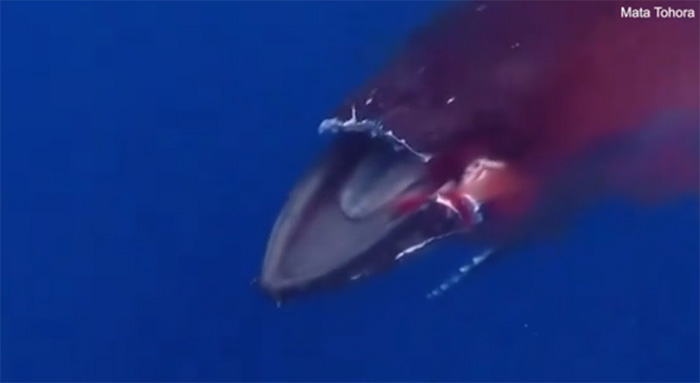Humpback whale in pain after ferry crashes into jaw
A head-on collision with a speeding ferry left a humpback whale with a deformed jaw and it died in agony within hours.
(Video: Sea Shepard).
The female whale, nicknamed Sweet Girl, was hit by a ferry traveling six times the speed limit while swimming near a port in Tahiti on October 8, according to the wildlife organization Sea Shepard. Photos taken by divers later showed the animal's upper jaw severed and blood gushing from the wound. Sweet Girl drowned after several hours of agony. The ferry was traveling at 35 mph through the port, against a speed limit of 5.5 mph.
Dr Agnès Benet, founder of the Mata Tohora marine conservation organization, said the whale died shortly after the organization's staff arrived. It drowned due to the impact of the collision, specifically fractures to its nasal bones. Mata Tohora and Sea Shepard have filed a complaint with local authorities, requesting an investigation into the violation of regulations. They are also appealing for witnesses to testify.
In a video shared by Sea Shepard, a trail of blood can be seen from the open wound in the whale's mouth as it struggles to surface. The young humpback can also be heard making painful cries. Rachel Moore, an underwater photographer who encountered Sweet Girl just four days before her death, said the whale's mouth was severely deformed.

Humpback whale in pain from ferry crash.
Every year, 20,000 whales die worldwide. There are about 3,200 humpbacks living around Tahiti and about 80,000 in oceans around the world. Whale watching is a major source of income in the region, and authorities are taking steps to promote sustainable tourism and protect the cetaceans. In April, they set a 100-meter (328-foot) safe distance between boats and whales.
However, environmental groups and scientists have criticized the whale-watching boom. According to Mata Tohora, there are too many boats on the water . "We need to limit the number of boats around whales and dolphins," stressed Agnes Benet, a biologist at Mata Tohora.
The humpback whale (Megaptera novaeangliae) is a large baleen whale. Its body length ranges from 12 to 16 m, and its mass can reach about 36 tons. The humpback whale has a distinctive body shape, with unusually long pectoral fins and a knobby head. The humpback whale's diet consists of mollusks and fish.
- See the amazing performance of humpback whales
- The 20 ton humpback humpback whale stands on the sea surface
- The hero scene dealt with the giant humpback whale
- The moment proves the intelligence of humpback whales when hunting
- Watch the classic jump of humpback whales
- You may not know: Humpback whales consume more than 18,000 tons of food every day
- Discovering an extremely rare albino humpback whale
- Floating into the mouth of the whale, the sea lion escaped death within a short distance
- Mysterious giant whale corpse found in the Brazilian jungle
- Witness the birth of a humpback whale off the coast of Hawaii
- The scientist communicated with the whale for 20 minutes
- Video: Rescue the lumpy humpback whale
 Surprised: Fish that live in the dark ocean still see colors
Surprised: Fish that live in the dark ocean still see colors Japan suddenly caught the creature that caused the earthquake in the legend
Japan suddenly caught the creature that caused the earthquake in the legend A series of gray whale carcasses washed ashore on California's coast
A series of gray whale carcasses washed ashore on California's coast Compare the size of shark species in the world
Compare the size of shark species in the world